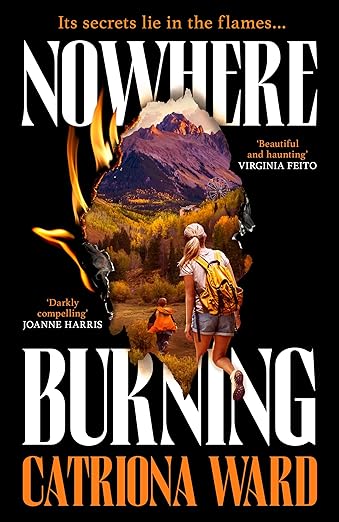The Hong Kong Widow with Kristen Loesch
A Hong Kong Widow tour with Kristen Loesch
How I Became Inspired to Write The Hong Kong Widow as a Historical Horror
Kristen Loesch
Locations in A Hong Kong Widow
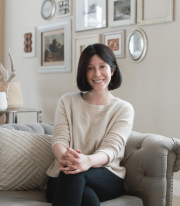
(c) Kristen Loesch
My second novel, The Hong Kong Widow, is a mix of many genres.
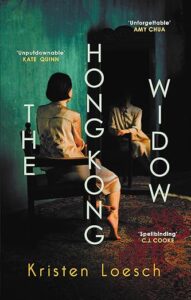
Locations in A Hong Kong Widow
I typically refer to it as a historical gothic thriller, centered on a young woman called Mei, who enters a séance competition at a haunted house…the events of which eventually become urban legend. But as you can probably tell from that single line, the novel is also a little bit horror. It is partially set in 1930s Shanghai, when Mei is only seven years old, and follows her as she grows up; in other words, it is also a little bit a coming-of-age tale. In the narrative, Mei meets the love of her life, and the novel is also a little bit a love story.
However, I set out intending to write a specific blend: Historical and horror.
Locations in A Hong Kong Widow
I wanted to write a novel set in mid-20th century China, and always planned to incorporate elements of my own family history into the story. I knew that my main character was going to grow up in northern China, be forced to move from a tiny, impoverished village to glamorous Shanghai, live through the Pacific War, and eventually flee the mainland during the Communist Revolution, just as my maternal grandfather did. For those who are interested in novels that take place against this historical backdrop, Melissa Fu’s Peach Blossom Spring, Weina Dai Randel’s The Last Rose of Shanghai, and Eve J. Chung’s Daughters of Shandong are some recent and outstanding examples. I was also deeply moved, as a child, by classics such as Amy Tan’s The Joy Luck Club and Jung Chang’s Wild Swans.
Victoria Peak, a key location in the book:
Locations in A Hong Kong Widow
The above novels, of course, are not horror (except insofar as what humans are capable of inflicting upon other humans). They are the kind of stunning, sweeping, incredibly important historical fiction that depict particular times and places carefully and beautifully, and I’ll never stop reading them.
But I wanted to write a ghost story.

Locations in A Hong Kong Widow
My debut novel, The Porcelain Doll, contained a very slight, blink-and-you’ll-miss-it supernatural element, and to put it simply, I wanted more.
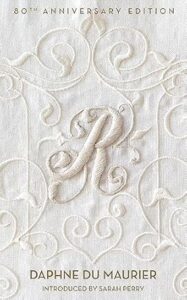
Locations in A Hong Kong Widow
Gothic fiction has always been one of my go-to genres as a reader, from Bram Stoker’s Dracula to Henry James’s The Turn of the Screw to Daphne du Maurier’s Rebecca to some of the greatest short stories ever written, in my opinion, such as Shirley Jackson’s “The Lottery” and Charlotte Perkins Gilman’s “The Yellow Wallpaper”.
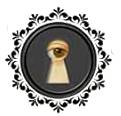
Locations in A Hong Kong Widow
The difference between gothic horror and other types of horror is often in the details: I find gothic horror to place more emphasis on atmosphere. It is dark, foreboding, mysterious, harrowing. Typically it’s not, however, overly gory, bloody, visceral, graphic. It is often more about the horror that you feel, rather than the horror that you see. (These are my own impressions, of course, and others’ views may well differ!) Over the past few years, I’ve found myself devouring books by authors such as Laura Purcell, Catriona Ward, and C.J. Cooke, and their work has had a profound influence on my own.
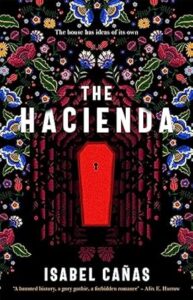
Locations in A Hong Kong Widow
Increasingly I have also seen a lot of recent historical horror in non-Western settings. Isabel Canas’s The Hacienda takes place during the Mexican War of Independence. Olesya Salnikova Gilmore’s The Haunting of Moscow House is set during the Russian Civil War. In both of these, and many more, the setting is in a way as important as the narrative itself: The reader gets the sense that this particular brand of horror could only happen in that country, in that culture. I was deeply inspired by such books to weave Chinese ghostlore into my own story.
The house in the novel is here:
Locations in A Hong Kong Widow
As I began my research, however, I felt quickly overwhelmed: By the sheer number of folktales, by the different and varying kinds of ghosts and hauntings that were possible, by the endless ghost-related traditions and cultural reference points. I spent a great deal of time combing through this body of lore, hoping to pick out tiny pieces and details that I thought I might be able to use in my novel, and I soon realized two things: One, that I was only ever going to be able to use a fraction of what I was unearthing, and two, that whatever I used, I wanted to use in some new, transformative, unexpected way.
Locations in A Hong Kong Widow
For example: There is a type of ghost in Chinese culture called a ‘Hanging Ghost’, notable for its long red tongue. In The Hong Kong Widow, Mei encounters a ghost who doesn’t have any tongue – whose tongue was cut off, when she was alive – and as a result, cannot speak. This ghost’s initial inability to communicate with Mei is crucial to the plot.
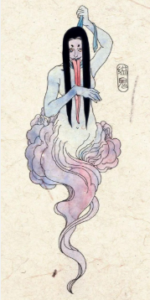
Hanging Ghost in China
In other words, I didn’t just want to borrow. I wanted to be inspired to create. And this, I think, is what underlies all the supernatural elements in my novel.
In the end, I’ll keep calling it a historical gothic thriller, but I will leave it to readers to decide what The Hong Kong Widow is most…
BookTrail Boarding Pass: The Hong Kong Widow
Twitter: @kristenloesch
Insta: @kristenloeschwriter/




